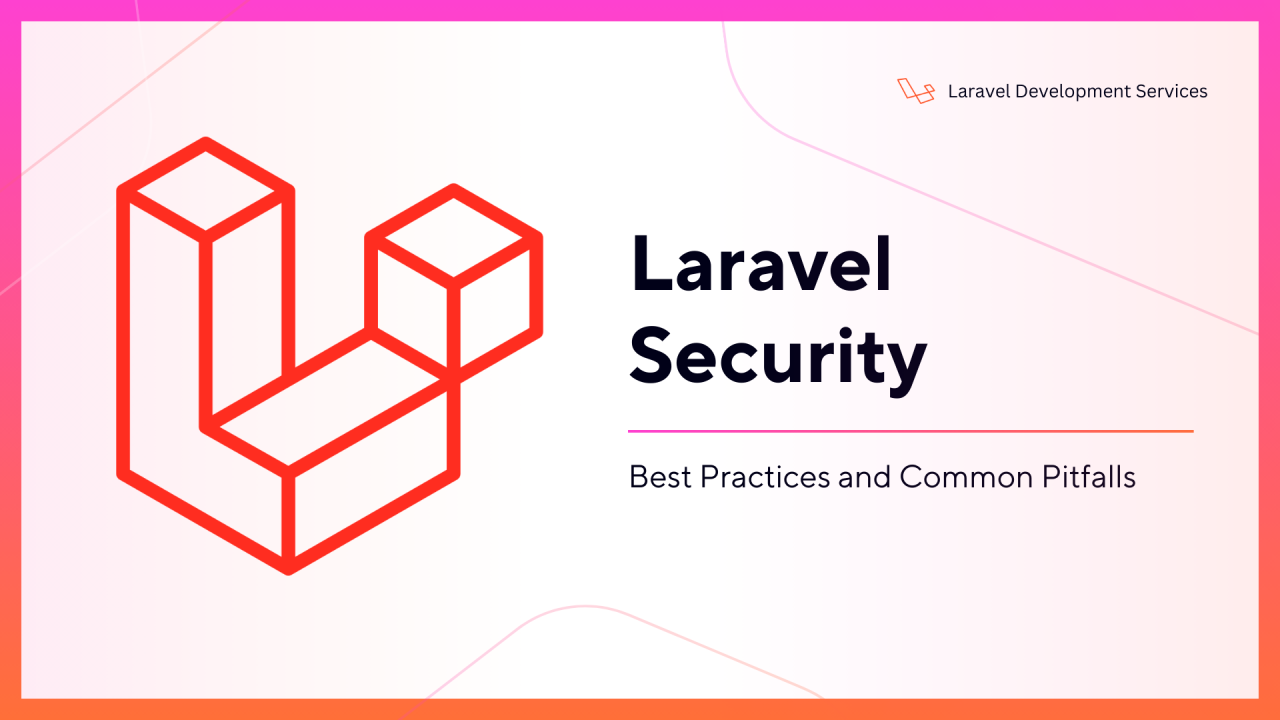I'm always excited to take on new projects and collaborate with innovative minds.
+1 762 259 2814
ahmettasdemir.com
I'm always excited to take on new projects and collaborate with innovative minds.
+1 762 259 2814
ahmettasdemir.com

Published: January 15, 2025 | Reading Time: 12 minutes | Category: Web Development Security
Laravel has become the most popular PHP framework for building secure, scalable web applications. However, even with Laravel's built-in security features, developers must implement additional security measures to protect their applications from modern cyber threats. In this comprehensive guide, we'll explore the latest Laravel security best practices for 2025.
Laravel 10+ makes implementing MFA straightforward. Here's how to secure user authentication:
// Install Laravel Fortify for advanced authentication
composer require laravel/fortify
// Enable two-factor authentication in config/fortify.php
'features' => [
Features::twoFactorAuthentication([
'confirm' => true,
'confirmPassword' => true,
]),
],
// Strong password validation rules
'password' => [
'required',
'string',
'min:12',
'regex:/^(?=.*[a-z])(?=.*[A-Z])(?=.*\d)(?=.*[@$!%*?&])[A-Za-z\d@$!%*?&]/',
'confirmed'
],
// Hash passwords with bcrypt (default in Laravel)
$hashedPassword = Hash::make($password);
Implement granular permissions using Laravel's Gate system:
// Define gates in AuthServiceProvider
Gate::define('manage-users', function ($user) {
return $user->hasRole('admin') || $user->hasPermission('manage-users');
});
// Use in controllers
if (Gate::allows('manage-users')) {
// User can manage other users
}
Laravel's Eloquent ORM provides built-in protection against SQL injection, but proper usage is crucial:
// SECURE: Using Eloquent parameterized queries
$users = User::where('email', $email)->first();
// SECURE: Using parameter binding
$users = DB::select('SELECT * FROM users WHERE email = ?', [$email]);
// INSECURE: Raw queries without binding (NEVER DO THIS)
$users = DB::select("SELECT * FROM users WHERE email = '$email'");
Configure fillable or guarded properties to prevent mass assignment vulnerabilities:
class User extends Authenticatable
{
// Allow only specific fields for mass assignment
protected $fillable = [
'name', 'email', 'password',
];
// Or protect sensitive fields
protected $guarded = [
'id', 'is_admin', 'email_verified_at',
];
}
Encrypt sensitive data at the database level:
// Use Laravel's built-in encryption
protected $casts = [
'social_security_number' => 'encrypted',
'credit_card_number' => 'encrypted',
];
// Manual encryption/decryption
$encrypted = Crypt::encryptString('sensitive data');
$decrypted = Crypt::decryptString($encrypted);
Laravel's CSRF protection is enabled by default, but ensure proper implementation:
<!-- Blade template CSRF token -->
<form method="POST" action="/user">
@csrf
<input type="text" name="name">
<button type="submit">Submit</button>
</form>
// Disable CSRF for API routes in VerifyCsrfToken middleware
protected $except = [
'api/*',
'webhook/*',
];
// Use API tokens instead for API authentication
Route::middleware('auth:sanctum')->group(function () {
Route::get('/user', [UserController::class, 'index']);
});
Implement CSP headers to prevent XSS attacks:
// Add CSP middleware
class ContentSecurityPolicyMiddleware
{
public function handle($request, Closure $next)
{
$response = $next($request);
$csp = "default-src 'self'; " .
"script-src 'self' 'unsafe-inline'; " .
"style-src 'self' 'unsafe-inline'; " .
"img-src 'self' data: https:;";
$response->headers->set('Content-Security-Policy', $csp);
return $response;
}
}
// Use Laravel's validation and sanitization
$validated = $request->validate([
'content' => 'required|string|max:1000',
'title' => 'required|string|max:255|alpha_dash',
]);
// HTML purification for rich text content
use HTMLPurifier;
$cleanContent = HTMLPurifier::clean($userInput);
public function uploadFile(Request $request)
{
$request->validate([
'file' => [
'required',
'file',
'mimes:pdf,doc,docx,jpg,jpeg,png',
'max:2048', // 2MB max
],
]);
$file = $request->file('file');
// Generate secure filename
$filename = Str::uuid() . '.' . $file->getClientOriginalExtension();
// Store outside public directory
$path = $file->storeAs('uploads', $filename, 'private');
return response()->json(['path' => $path]);
}
// Advanced file validation
'file' => [
'required',
'file',
function ($attribute, $value, $fail) {
$allowedMimes = ['application/pdf', 'image/jpeg', 'image/png'];
if (!in_array($value->getMimeType(), $allowedMimes)) {
$fail('Invalid file type.');
}
},
],
// Install and configure Sanctum
composer require laravel/sanctum
// Create API tokens
$token = $user->createToken('api-token')->plainTextToken;
// Protect API routes
Route::middleware('auth:sanctum')->group(function () {
Route::apiResource('posts', PostController::class);
});
// Configure rate limiting in RouteServiceProvider
RateLimiter::for('api', function (Request $request) {
return Limit::perMinute(60)->by($request->user()?->id ?: $request->ip());
});
// Apply to routes
Route::middleware(['auth:sanctum', 'throttle:api'])->group(function () {
// Protected API routes
});
class ApiController extends Controller
{
public function store(Request $request)
{
$validated = $request->validate([
'title' => 'required|string|max:255',
'content' => 'required|string',
]);
// Don't expose sensitive data in API responses
$post = Post::create($validated);
return response()->json([
'data' => $post->only(['id', 'title', 'content', 'created_at']),
'message' => 'Post created successfully'
], 201);
}
}
# Use strong, unique keys
APP_KEY=base64:STRONG_RANDOM_KEY_HERE
DB_PASSWORD=COMPLEX_PASSWORD_123!@#
# Disable debug in production
APP_DEBUG=false
# Use HTTPS in production
APP_URL=https://yourdomain.com
# Secure session and cache drivers
SESSION_DRIVER=redis
CACHE_DRIVER=redis
# Configure secure mail settings
MAIL_ENCRYPTION=tls
// Add security headers middleware
class SecurityHeadersMiddleware
{
public function handle($request, Closure $next)
{
$response = $next($request);
$response->headers->set('X-Content-Type-Options', 'nosniff');
$response->headers->set('X-Frame-Options', 'DENY');
$response->headers->set('X-XSS-Protection', '1; mode=block');
$response->headers->set('Strict-Transport-Security', 'max-age=31536000');
$response->headers->set('Referrer-Policy', 'strict-origin-when-cross-origin');
return $response;
}
}
composer require --dev enlightn/security-checker
composer require spatie/laravel-permission
composer require spatie/laravel-backup
composer require laravel/telescope --dev
// Monitor failed login attempts
Event::listen('auth.failed', function ($credentials) {
Log::warning('Failed login attempt', [
'email' => $credentials['email'],
'ip' => request()->ip(),
'user_agent' => request()->userAgent(),
]);
});
APP_DEBUG=false in production# Regular security updates
composer update
php artisan optimize:clear
# Security audit
composer audit
php artisan route:list --columns=Method,URI,Middleware
Laravel provides excellent security features out of the box, but implementing these additional security measures ensures your web applications can withstand modern cyber threats. Remember that security is not a one-time implementation but an ongoing process that requires regular updates and monitoring.
By following these Laravel security best practices, you'll build more secure web applications that protect both your business and your users' data.
Need expert Laravel security implementation? Contact our team for professional Laravel development and security consulting services. We specialize in building secure, scalable web applications that meet the highest security standards.
Tags: Laravel Security, Web Application Security, PHP Security, Laravel Best Practices, Cybersecurity, Web Development
Your email address will not be published. Required fields are marked *